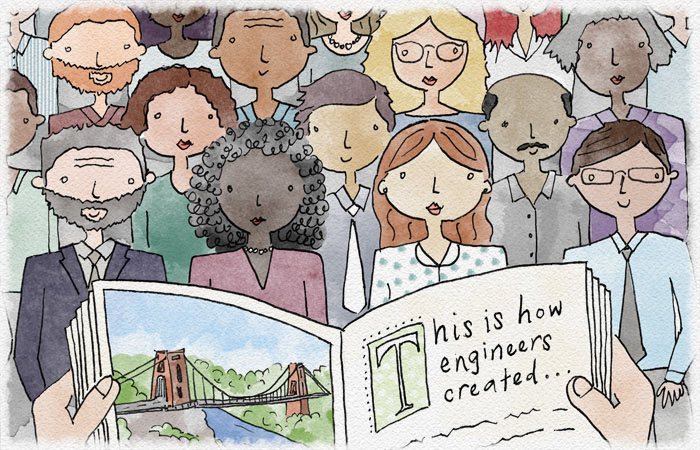The story of humankind is essentially one fantastic read, peppered with drama, tragedy and hair-raising exploits of heroism. From the first rock paintings through to Facebook, humanity has had a penchant for posting its legacy on walls. The oral and written word has always been one of our most powerful tools to reflect and reimagine our world and the role we play within it.
“All great literature is one of two stories; a man goes on a journey or a stranger comes to town.” If Leo Tolstoy’s words are true, then engineers have the world’s best stories that are yet to be written. A good engineer is a classic sojourner ̶ constantly navigating ideas into reality.
And yet, in spite of how essential engineering is to human society, as a profession it remains largely an untold tale, as most engineers don’t recognise there is a story that needs telling – one in which their profession is the hero. When asked about our projects, we speak in the technical when we should speak in the emotional. Our legacies should be celebrated from the rooftops of the city skylines we have helped to build.
Engineers would do well to upskill themselves and embrace those most famous words: “Let me tell you a story…” Without these words, you could be the best engineer in the world, but unless you can get people to understand what you have done and the value you have created, then nobody will ever know.
Our story is robust and essential to the big picture narrative, but we need to know how to share it in order to foster rich communication and meaningful collaboration going forward. Our expertise needs to find a new language that is captivating, relevant and persuasive to listening ears.
See also: Let’s make it easier for the UK’s tech and engineering sector to succeed
The power of the narrative
Like never before, now is the time for engineers to find their voice and tell stories…not just stories about where we have come from, but stories about where we are heading. As technologists, engineers are best placed to understand what emerging technologies will mean to people’s lives. Most people are guessing what a world with autonomous vehicles or blockchain or artificial intelligence will look like and mean.
As the creators of these technologies, engineers can paint that picture and reassure people of the benefits that will be created. But to do so, they have to find their own voice. They have to move from “Once upon a time…” to “Just imagine a future where…”
In today’s world, the engineer often plays supporting roles in the story of design, sitting back to give the traditional spokesperson centre stage. But our reticence impoverishes the process; our expertise and knowledge are critical to the collective narrative. Engineers should be the custodians of the design narrative. This is a narrative about the future.
In the era that ensued the great industrial revolutions of the pasts, iconic engineers such as Isambard K Brunel and Gustav Eiffel were the custodians of design narrative. We need to reimagine a similar role for ourselves in this digital revolution age. Looking forward, ‘Engineering-led Design’ suggests that our best ideas are yet to come. This highly collaborative process hinges on a depth and breadth of expertise working together to tell a much bigger story. As we work with government and economic leaders to reimagine our physical spaces and infrastructure, engineers need to lead these conversations.
Lessons in leadership
A century ago, engineers like Brunel and Eiffel were living through a pivotal point of change. The emergence of new technologies stimulated them not to shrink back, but to explore new creative and dazzling horizons. These engineers were leaders in the application of new material technologies, construction techniques and ways of thinking about design. They were the trailblazers.
Our challenge is to redefine the role we play as engineers, in particular to sit at the top of the innovation chain of design. Just as Brunel or Eiffel were creators of solutions, not technical functionaries who delivered designs others had conceptualised, we need to trailblaze and excel.
In today’s terms, Elon Musk changed the energy debate, leading the agenda as opposed to following political direction. He has transformed the challenge of stabilising the national grid into an engineering-led debate.
People before product
Engineers are at the forefront of the innovations that help solve the most complex challenges facing humanity and make the most ambitious scientific endeavours possible. Our work matters because it has exponential impact on society. We carry fundamental knowledge and skills that provide the framework for how the world works, and we intrinsically understand how to correlate and synthesise these processes to facilitate human progress.
But the value we offer as engineers is not only in the products we co-design. Our value lies in the knowledge we can unlock in others. Part of our storytelling journey is to translate information into wisdom, and to bring our problem-solving processes to the human-centric values they create ̶ transcending understandings of the world and our place within it. Knowing how it all works is not enough. It’s about the people and communities a particular design works for.
We need to work together to evolve building typologies beyond the mundane and into new territory. Brisbane’s new Ferry Terminals have become synonymous with a forward-looking attitude to the design of public transport infrastructure and enhance commuters’ experience of and connection to the city’s key natural feature — its river.
The packaging also matters
In order to make the narrative memorable, the message must be simple. Why is this model of sustainable design important to the public? How will this breakthrough technology propel innovation to higher standards of health and safety? The story must also come with faces and names, emphasising the interconnectedness between our built environments and the occupants they serve. Authentic and fleshy, honest and on the ground, the engineer’s story is ultimately about people. The tools and technologies which we master are merely the scaffolding, but the design brief is humanity itself.
The first known engineer is said to be Imhotep, whose invention of the Step Pyramid was so transcendent and inspiring that Ancient Egypt decided to pay him the compliment of making him a god for the next 3200 years. Idolatry is no longer up for debate, but aspiration is.
Engineers do the creative process no favours by downplaying our capacity to captain thought leadership and drive future change. Our contribution weaves through the major themes and plot lines of humankind’s entire story. It’s time we start sharing it. If engineering is to move on from being an ‘invisible profession’ – we must understand our pivotal role; and then make friends with the words “Once upon a time…”
Dr Kourosh Kayvani is Aurecon’s global head of excellence and expertise discusses how engineering stories are essential to shaping the design narrative, but unless we learn how to tell them, engineers will never be able to move on from being an ‘invisible profession’ into future makers. This post originally appeared on Aurecon’s Just Imagine blog.







